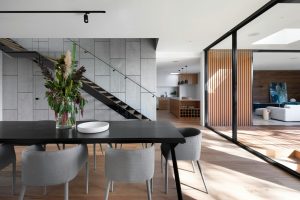Quantum Architecture: Reimagining Living Spaces Through Dimensional Design
Imagine a world where living spaces are designed not just to meet our basic needs, but to transcend our current understanding of what a home can be. This is the concept behind Quantum Architecture, a revolutionary approach to designing living spaces that goes beyond traditional forms and challenges our perceptions of space, time, and dimension. In this article, we will explore the fascinating world of Quantum Architecture and how it is redefining the ways in which we experience and interact with our homes. Get ready to have your mind expanded and your ideas of what makes a house a home transformed.
What is Quantum Architecture?
Quantum Architecture is an innovative design philosophy that combines principles from quantum mechanics, mathematics, and architecture to create living spaces that are not limited by our traditional notions of dimensions. Inspired by the mysteries of the quantum world, this approach to architecture breaks away from conventional methods and embraces the concept of multidimensionality. Simply put, Quantum Architecture looks beyond the constraints of three-dimensional space and explores the possibilities of higher dimensions.
The Concept of Dimensional Design
So, what exactly is dimensional design? In traditional architecture, we are used to working with three dimensions – length, width, and height. However, according to quantum theory, there are potentially infinite dimensions that exist beyond these three. These dimensions are not tangible in our physical world, but they are essential in understanding the complex nature of our reality.
Dimensional design, as applied in Quantum Architecture, takes into consideration these higher dimensions and incorporates them into the planning and creation of living spaces. This means that architects are no longer limited to designing within a confined three-dimensional space, but can explore the possibilities of additional dimensions to create truly unique and dynamic living environments.
The Principles of Quantum Architecture
At the core of Quantum Architecture are four key principles that guide the design process. These principles are derived from the laws of quantum mechanics and are based on the idea that everything in the universe is interconnected and constantly in a state of transformation.
Superposition
In quantum mechanics, superposition refers to the ability of a particle to exist in multiple states at once. This concept is applied in Quantum Architecture by allowing living spaces to be designed in a way that they can serve multiple functions and transform according to the needs of their inhabitants. For example, a room can double as a bedroom and a home office, or a living room can also be a workout space.
Entanglement
Entanglement in quantum mechanics describes the phenomenon where particles become connected and affect each other, even when separated by great distances. In Quantum Architecture, this concept is applied by creating living spaces that foster a sense of connectedness between individuals and their surroundings. This can be achieved through the use of open floor plans, natural lighting, and incorporating elements of nature into the design.
Uncertainty
Uncertainty is a fundamental principle in quantum mechanics, where it is impossible to know both the position and the momentum of a particle at the same time. In Quantum Architecture, this principle is utilized by creating spaces that allow for flexibility and evolution over time. This can be achieved through the use of modular design, adaptable furniture, and smart technology that can be easily modified to suit changing needs.
Wave–Particle Duality
According to quantum theory, particles can sometimes behave like waves, and waves can sometimes behave like particles. This concept is applied in Quantum Architecture by incorporating elements of fluidity and movement in the design of living spaces. This can be seen in the use of curved lines, flowing patterns, and materials that have a sense of motion, such as water or wind.
The Benefits of Quantum Architecture
If you’re wondering what the practical applications of Quantum Architecture are, the answer is – many! By breaking away from traditional design methods, this approach offers numerous benefits to both homeowners and the environment.
Increased Creativity and Personalization
Quantum Architecture allows for a more creative and personalized approach to home design. With the incorporation of higher dimensions, living spaces can be tailored to suit the specific needs and preferences of the individuals living in them.
Efficiency and Sustainability
By considering the interconnectedness of all things, Quantum Architecture promotes a more sustainable design approach. This includes the use of eco-friendly materials, energy-efficient designs, and incorporating elements that promote health and well-being.
Enhanced Well-being
The principles of Quantum Architecture, such as connectedness and uncertainty, can help create living spaces that have a positive impact on our physical, mental, and emotional well-being. By designing spaces that evolve and adapt to our needs, we can feel more in tune with our environment and in turn, experience greater levels of happiness and contentment.
The Future of Living Spaces
As we continue to push the boundaries of design and technology, Quantum Architecture offers a glimpse into the future of living spaces. It challenges us to think beyond the limitations of our current understanding and envision a world where our homes are more than just a place to sleep and eat, but rather a reflection of our constantly changing and evolving selves.
The concept of Quantum Architecture may seem like an abstract and distant reality, but with advancements in science and technology, it is closer than we think. So, the next time you step into a traditional three-dimensional room, take a moment to wonder what it would look like if it were designed with an extra dimension in mind.
The Possibilities are Endless
With its limitless potential for creativity, sustainability, and well-being, Quantum Architecture has the power to revolutionize the way we live and experience our homes. Imagine living in a space that changes and adapts with you, rather than the other way around. As the saying goes, the only limit is the one we set for ourselves – and with Quantum Architecture, those limits are constantly being reimagined and expanded.










